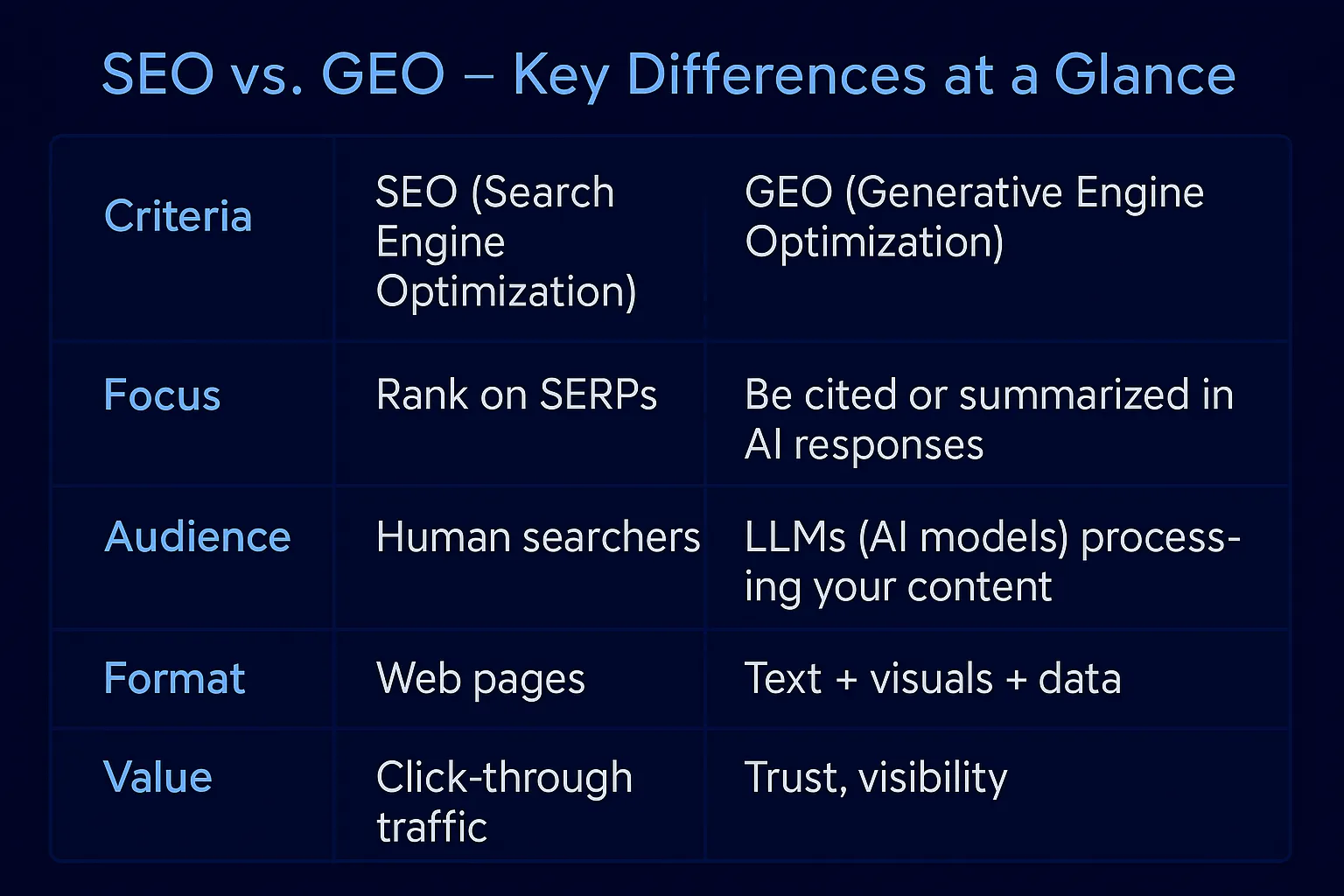
News
SEO vs GEO: What Is Generative Engine Optimization and Why It Matters in 2025
April 4, 2025

News
April 4, 2025
What if your publication became the primary source that AI platforms consistently reference?
85% of news organizations were either utilizing or experimenting with generative AI tools in their newsrooms. This widespread adoption underscores a significant transformation in content creation and distribution. For publishers, the challenge is to ensure that their content remains authoritative and becomes the preferred choice for AI-driven platforms.
Welcome to the era of Generative Engine Optimization (GEO) — where the objective is to position your content as the definitive source that AI platforms rely upon. In this article, we explore how GEO is not replacing SEO, but reshaping it. You'll learn the key differences, strategic implementations tailored for publishers, and how to maintain discoverability, engagement, and authority in AI-driven search environments.
Search has evolved beyond the traditional list of blue links. With the advent of AI-generated answers, readers are increasingly satisfied directly within the search experience—without clicking through.
For publishers, this introduces Generative Engine Optimization (GEO): a way to ensure your articles, news reports, and features aren’t just indexed—they’re surfaced, cited, and trusted by AI-powered search tools. This is your playbook to stay relevant and discoverable.
Search Engine Optimization (SEO) has long been the backbone of traffic strategies for publishers. It's how content gets ranked, indexed, and discovered via traditional search engines like Google and Bing.
SEO Core Elements for Publishers:
SEO helps you get found. GEO helps you get featured.
Generative Engine Optimization (GEO) is the method of optimizing your content so that AI-powered search engines—like Google’s AI Overviews or ChatGPT—select your content to generate responses.
Unlike SEO, which tries to earn a click, GEO is about becoming the answer.SEO focuses on visibility. GEO focuses on influence.
In publishing, attention = revenue. GEO ensures your stories stay top-of-mind—even if users stay on the search engine.
| Factor | SEO | GEO (Generative Engine Optimization) |
|---|---|---|
| Goal | Drive clicks | Be the cited source in AI summaries |
| Optimization Focus | Keywords, backlinks | Structure, clarity, trust signals |
| Metrics | CTR, ranking, traffic | Citations, mentions, AI inclusion |
| Format Preference | Long-form, optimized pages | TL;DRs, tables, lists, quotes, schemas |
| Tools Used | GSC, SEMrush, Ahrefs | Perplexity, BuzzSumo, schema validators |

AI-generated search isn’t a future trend. It’s already here. Gartner predicts a 50% drop in traditional organic traffic by 2028 due to the proliferation of AI-driven search.
But where traffic declines, brand impressions, trust, and citation authority can surge—if you optimize for GEO. With AI tools generating content previews, being the quoted source is the new SEO win.
Generative engines synthesize information from multiple sources and respond to queries conversationally, contextually, and often visually.
Top Generative Engines to Know:
They decide which publisher content gets cited, quoted, or distilled. If you’re not training these models with your content—someone else’s story will be chosen.
GEO involves shaping your stories for synthetic summarization:
In this environment, well-structured reporting will outrank raw volume.
According to recent studies, the following tactics drastically increase inclusion in AI-generated results:
Schema markup is essential because it’s how Google—and other AI systems—read and understand your content beyond just the text on the page. If your content is already well-structured and clearly written, algorithms can often make sense of it. But adding schema manually helps facilitate and speed up that process, giving search engines and AI tools a clearer signal of what your page is about—faster.
By applying structured data for articles, FAQs, and how-to content, you increase the chances of appearing in rich results, featured snippets, and AI-generated responses. FAQ schema lets you showcase concise answers directly in search; HowTo markup turns step-by-step content into visual guides; and Article schema strengthens metadata like author name and publish date—boosting authority and clarity.
You don’t need to start from scratch. Tools like Google’s Structured Data Markup Helper or schema generators make it easy to add. Think of schema as a way to speak directly to the machines—it’s not just good SEO; it’s the fast lane to being properly indexed and featured.
Experience, Expertise, Authoritativeness, Trustworthiness — this framework is embedded in Google's ranking algorithm and now more critical than ever for generative AI.
Your bylines, editorial standards, and transparent sourcing build trust not only with readers but with LLMs scanning the web for:
63% of users trust AI-generated content when the source is credible, emphasizing the need for trustworthy brand signals. Therefore, GEO demands content that doesn’t just look authoritative — it has to be authoritative.
AI engines favor content types that help them “think” faster. Featured snippets, for instance, are 77% more likely to include bulleted or numbered lists.
Content structures that generative AIs love also include:
Traditional analytics don’t tell the whole story. Add:
By 2026, 30% of all browsing sessions will be screenless, driven by AI and voice-first interfaces. And as these platforms mature, first-mover publishers will dominate the citation space.
Don’t abandon SEO. Merge it with GEO.
Search has changed. Permanently.
Publishers who:
...will thrive.
GEO is not the end of SEO. It is its evolution. Start now. Experiment. Test. Track. Iterate.
Don’t just keep up — get ahead. Explore our expert deep dives to stay sharp and search-savvy:
🔗 AI-Powered SEO: How Digital Publishers Can Stay Ahead
🔗 AI in Publishing: The Future of Content
🔗 DeepSeek: The Next AI Giant or a Hidden Threat to Publishing?